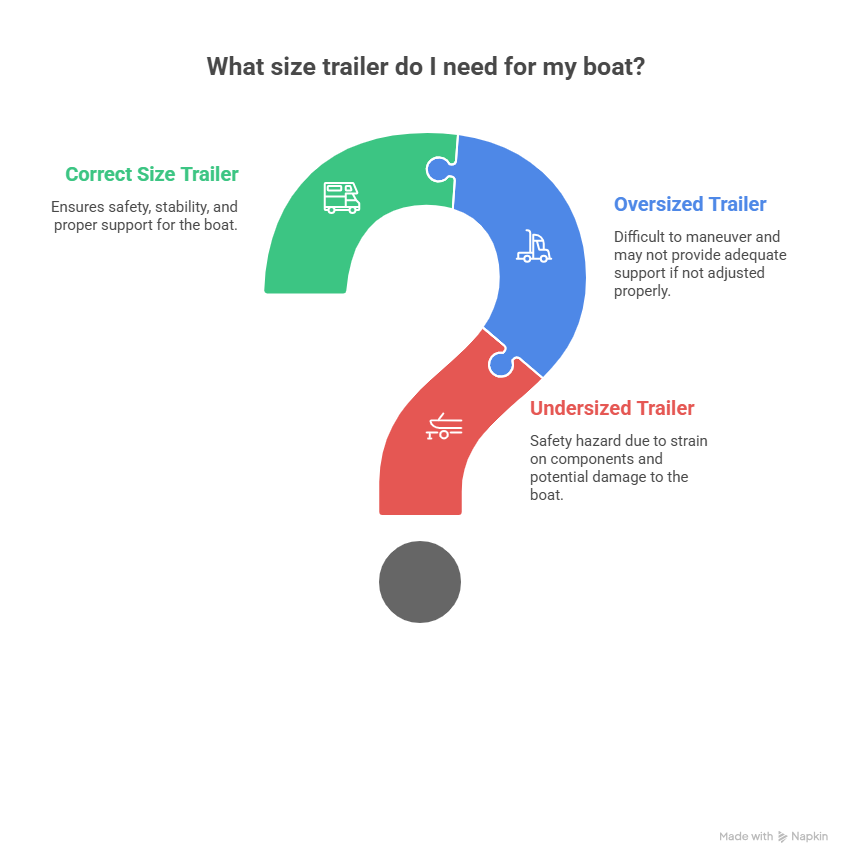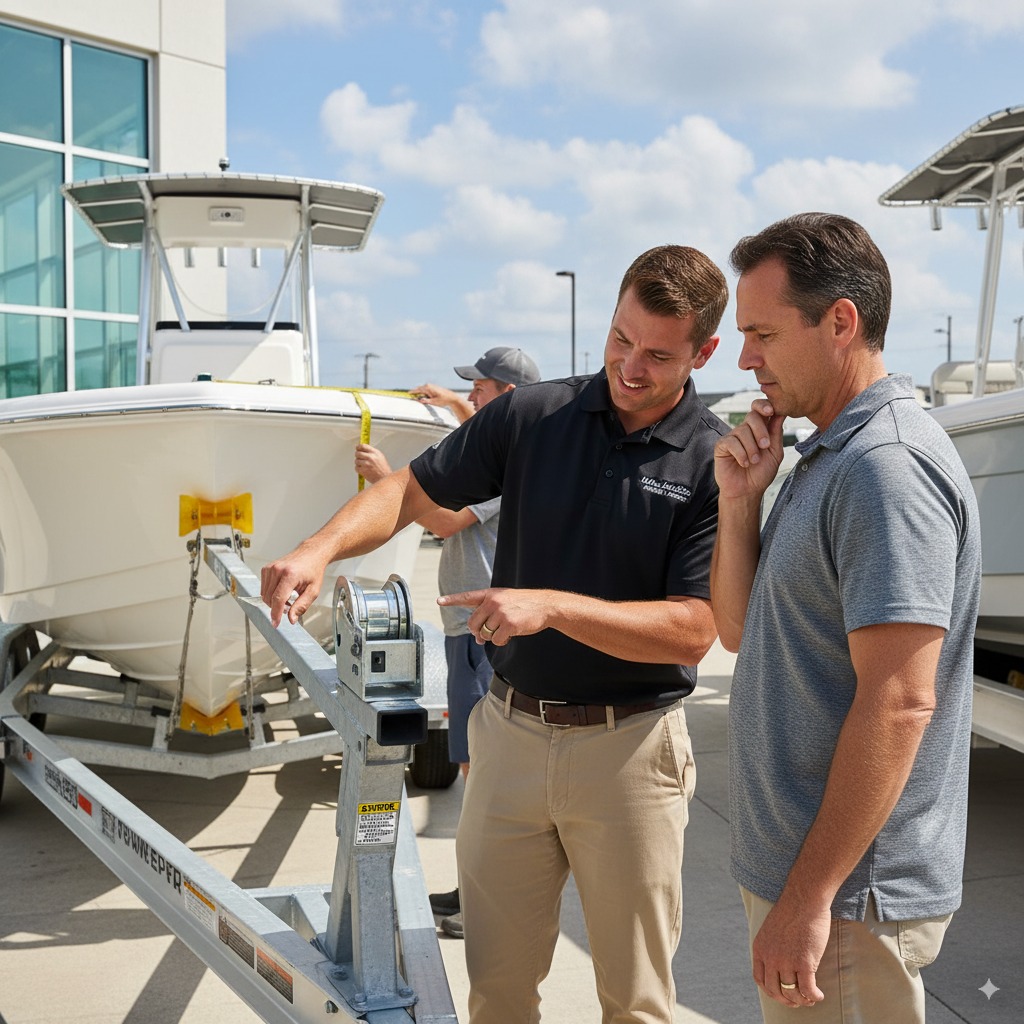I’ve been a marine mechanic in South Florida for 15 years, and I’ve seen it all. But the mistakes that make me cringe the most happen before the boat even touches the water. I’m talking about trailers. I remember a guy, Ray, who bought a beautiful 24-foot center console. He was so excited. He got a “deal” on a trailer from some guy online. The first time he tried to tow it down the highway, the trailer started swaying so badly he almost ended up in a ditch. The trailer was undersized, the tongue weight was wrong, and the bunks weren’t supporting the hull correctly. It was a disaster waiting to happen.
He came to my shop, frustrated and scared, asking, “What size trailer do I need for my boat?” It’s the most important question a boat owner can ask, and it’s the one that gets overlooked the most.
Your trailer isn’t just a set of wheels to get you to the ramp. It’s the foundation that protects your boat on land. Getting it wrong can cause everything from minor gelcoat cracks to catastrophic hull failure. So, let’s walk through this, the way I explain it to my customers, so you can tow with confidence.
Table of Contents
Why Getting the Size Right Is a Really Big Deal
I can’t stress this enough: a mismatched trailer is a safety hazard, plain and simple.
An undersized trailer is the most common problem. You’re asking a piece of equipment to do a job it wasn’t built for. The axles, tires, and frame are all under constant strain. This leads to blown tires, failing bearings, and a terrifyingly unstable tow. I’ve seen hulls get “hooked” or warped from sitting on a trailer that’s too small, causing thousands in damage.
But a trailer that’s too big isn’t a great solution either. It can be a nightmare to maneuver, and if the bunks or rollers aren’t adjusted perfectly, your boat can be just as unsupported as it would be on a small trailer. When people ask me, “What size trailer do I need for my boat?“, they’re often just thinking about weight, but the physical fit is just as crucial.
The Numbers Game: How to Measure Your Boat Correctly
Before you even look at trailers, you need to know your boat’s real numbers. And I don’t mean the ones the manufacturer printed on the brochure.
1. The “Wet” Weight: The Only Number That Matters
The dry weight is a fantasy. Your boat never weighs its dry weight. You need the “wet” or “loaded” weight. It’s the number one mistake I see. People forget that fuel, water, gear, and engines add up fast.
Here’s how you calculate it:
- Boat’s Dry Weight: Find this in your owner’s manual.
- Engine Weight: Don’t forget the kicker motor if you have one.
- Fuel: Gasoline weighs about 6 pounds per gallon.
- Water: Fresh water is about 8.3 pounds per gallon.
- Gear: Batteries, coolers, anchors, safety equipment—add a conservative estimate. I usually tell people to add at least 500 lbs for gear.
Add all that up, then add another 15-20% as a safety margin. Trust me on this. It gives you a buffer and ensures your trailer isn’t always operating at its absolute limit. This calculation is the first step to answering, “What size trailer do I need for my boat?“
2. Length: Bow Eye to Transom
For trailer fitting, you need the length from the bow eye (where the winch strap connects) to the transom (the back of the boat). Do not include the swim platform or the outboard motor. The trailer’s job is to support the hull, so that’s the length that counts. An improper fit here puts immense stress on the transom.
3. Beam: The Widest Point
The beam is the boat’s widest point. This measurement determines if your boat will fit between the trailer fenders. As a rule of thumb, if your beam is over 80 inches, you’ll likely need a trailer specifically designed for a wider boat.
Axles, Brakes, and Bunks: Decoding the Trailer Itself
Once you have your numbers, you can start looking at trailers. Let’s break down the key features.
Axles: Single vs. Tandem
This is a huge factor in stability and safety.
| Axle Type | Best For | My Take |
|---|---|---|
| Single Axle | Lighter boats, typically under 3,000 lbs loaded weight. | Easier to move around by hand and less maintenance. But if you have a blowout, you’re stuck on the side of the road. |
| Tandem (Dual) Axle | Heavier boats, over 3,000 lbs loaded weight. | Way more stable on the highway. Less sway, and if you get a flat, you can usually limp to a safe spot to change it. A must-have for heavier boats. |
For anything big or heavy, don’t even question it. Get the tandem axle. It’s the safest answer to “What size trailer do I need for my boat?“
Brakes: They’re Not Optional
In most states, if your combined boat and trailer weight is over 3,000 lbs, you are legally required to have trailer brakes. But honestly, I recommend them on any trailer over 2,000 lbs. They dramatically improve your stopping distance and take a huge load off your tow vehicle’s brakes. This is a safety feature you should never skimp on.
Bunks vs. Rollers
- Bunk Trailers: These have long, carpeted boards that the hull rests on. They provide excellent support across the entire length of the hull, which is great for long-term storage. They can be a little tougher to launch and load, especially at shallow ramps.
- Roller Trailers: These use a series of rollers to make launching and loading incredibly easy. They are great if you use a lot of different ramps. The downside is they are more expensive and provide more concentrated points of pressure on the hull.
For fiberglass boats, I usually recommend bunks for the superior support. For aluminum boats, rollers are often a great choice.

Putting It All Together: A Final Checklist
So, when you’re standing on a lot looking at trailers, how do you make the final call? This is the final step in figuring out “What size trailer do I need for my boat?“
- Check the Capacity Plate: Every trailer has a plate with its GVWR (Gross Vehicle Weight Rating). This is the maximum weight the trailer can handle, including the trailer itself. Your boat’s “wet” weight plus the weight of the trailer must be less than the GVWR.
- Look at the Fit: Is the winch stand adjustable? Can the bunks be moved to perfectly cradle your hull? A good fit is as important as capacity.
- Think About the Future: Are you planning on adding a heavier motor or more gear later? Buying a trailer with a little extra capacity is always a smart move.
FAQ: Questions I Hear All the Time
What happens if my trailer is too small?
You risk trailer failure (axles, tires), poor towing performance (sway), and potential damage to your boat’s hull from lack of support. It’s unsafe and I strongly advise against it.
Can my trailer be too big for my boat?
Yes. If the trailer is too long or wide, you can’t get the bunks or rollers positioned correctly to support the hull. This can cause just as much damage as a trailer that’s too small.
How do I know if I need a tandem axle?
My rule is simple: if the total weight is over 3,000 lbs, you should have a tandem axle for safety and stability. Don’t let a salesman talk you out of it to save a few bucks.
What’s the most important measurement when asking, “What size trailer do I need for my boat?”
The “wet” weight. It’s the number that determines the trailer’s capacity, axle needs, and brake requirements. Get this number wrong, and everything else is wrong.
How much should my trailer overhang the boat?
Ideally, none. The transom of your boat should be fully supported by the rearmost bunks or rollers. An overhang of more than a foot can put a huge amount of stress on the transom.
Author Bio
I’m Alex, a 15-year marine technician in South Florida, ABYC-certified. I’ve seen firsthand what happens when a trailer fails. From setting up new boat and trailer packages to repairing hull damage from improper support, I’ve helped countless boaters at marinas like Dinner Key and Bahia Mar get the right foundation for their vessel.


Leave a Reply